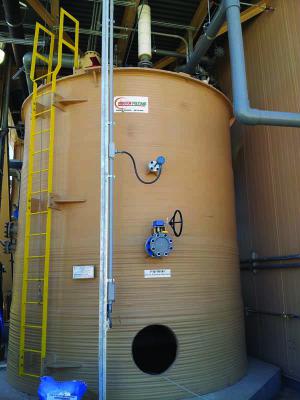Aggressive chemical tanks needed for rare earth mine
Problem: A rare earth mine in California needed many skirted, cone-bottomed mixing tanks and reactors to mix aggressive chemicals, such as cerium, lignosulfonate and sulfuric acid, at elevated temperatures. Because of strict California laws, the tanks needed to have four 24-inch access holes cut into the skirted cylinder base to create a non-confined space under the cone.
Solution: Houston PolyTank built multiple 10,000-gallon polyethylene and polypropylene skirted cone-bottomed reactor tanks with a mixer mount right on top of the tank. Baffles on the inside of the tank promoted proper mixing of the cerium and increased the heat transfer coefficient and possible chemical reaction rates. Because of the extrusion-wound manufacturing process, these tanks can have wall thicknesses between 1/2 and 6 inches that can support 2,000 pounds on the top of the tank to hold a mixer without building any external structure.
Result: The tanks continue to perform as intended. 800/852-8265; www.houstonpolytank.com.
Sustainable alternative manages produced water at oilfield
Problem: Pacific Rubiales Energy Corporation, an independent oil and gas exploration and production company in Columbia, produces 165,000 barrels of oil daily. During the production process, large quantities of natural groundwater are extracted with the petroleum. The brackish feed water contains residual oils, hydrocarbons, solids and other contaminants. The cost, strict regulations and environmental impact of deep well injection motivated the company to look for an alternative solution to maximize water reuse while significantly reducing brine disposal.
Solution: RWL Water designed, built and commissioned a multistage, fully automated treatment plant and desalination plant. The plant can accommodate approximately 500,000 barrels per day of treated produced water, and is designed to treat 90 percent of the feed water to levels that meet irrigation standards, while 10 percent (including the reverse osmosis brine) is disposed of via deep well reinjection. Other waste streams from the plant are treated and converted to solid sludge for landfill disposal.
Result: The advanced water treatment solution provides a successful, sustainable alternative to manage water production. 800/879-3677; www.rwlwater.com.
Used oil container recycler replaces manual labor and improves safety with vacuum system
Problem: Removing polymer, sludge and residual oil from IBC totes, bins and drums using a forklift and shovel was manually intense and time-consuming for RBW Waste Management in Alberta, Canada. Spills created slip hazards and exposure to fumes.
Solution: Adding a portable vacuum system with wand attachment from Swift Environmental to the shop floor, they created two recovery tanks for separating acids and polymers by using the power of the vacuum to connect to the recovery tanks, allowing workers to separate waste that cannot be mixed. Once the waste is collected, the tanks are emptied and contents are safely removed.
Result: The system allowed workers to remove polymer from totes in seconds, and leak testing was more efficient and less labor intensive for workers. The vacuum is also used for cleaning sumps, floors and other functions, reducing the frequency of vacuum truck services. 780/469-6365; www.swiftenv.com.






Comments